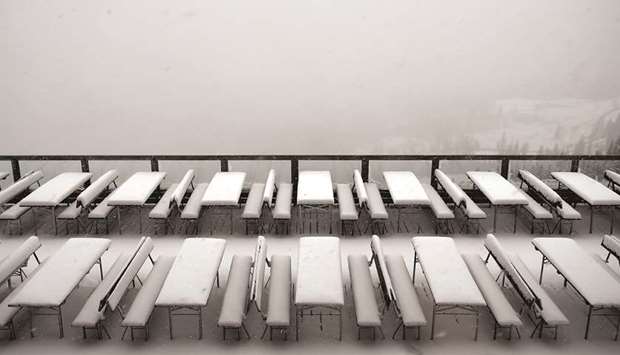High-altitude Alpine ski resorts might be celebrating heavy snowfalls this season. But as tour operators and businesses cash in, such hardy winters will become only rarer in the future. By Christiane Oelrich
Alpine researcher Werner Baetzing gives classic winter tourism with downhill skiing in the Alps only two decades more.
“The skiing is now partially reliant on artificial snow and a lot of effort. It might go on like that for another 15 years, with ever higher costs, but in 20 years, it’s over,” he warns.
Climatologist Christoph Marty, from the Institute for Snow and Avalanche Research (SLF) in the Swiss town of Davos, also views this winter’s thick snowfall in the Alps as a whim of nature. The long-term warming trend remains unchanged, he agrees. “The temperature rise is too dominant. The last three winters were way too warm,” he says.
Despite the current snow bonanza, the winter of 2017-18 will likely also be warmer than the long-term average. Moreover, there was only a lot of snow at high altitudes.
“But even up there we see an increasing number of days that are so warm, that precipitation falls as rain rather than snow,” Marty adds.
Snow volumes in the Alps are expected to decline by 70 per cent by the end of the century, according to a study co-authored by the climatologist.
When considering snow levels at an altitude of 300 to 800 metres, there have been only three years with more snow than the long-term average since the beginning of the 1990s. All the others had less.
“Fifteen years ago, ski resorts were still heavily dependent on natural snow. Today, many can no longer guarantee snow without using artificial snow,” says Marty.
Artificial production is the solution, says Austria’s national winter sports and tourism platform Allianz Zukunft Winter. “The bottom line is that this business is about snow,” says the organization’s current strategy paper.
Sinking billions of dollars into cable car operations to reach more areas with reliable natural snow is also seen as viable.
But maintaining ski tourism with snow machines increases climate-damaging CO2 emissions. “Artificial snow-making is more likely to come from non-renewable resources,” says Marty.
France, the largest Alpine downhill operator with some 8,000 kilometres of slopes - against Austria’s 6,800 and Switzerland’s 5,800 kilometres - is banking on expanding usable slopes.
It’s also tapping China’s giant winter sports market.
The ski company Compagnie des Alpes is actively courting the Chinese concern Fosun, which owns the Club Med family.
“By 2022, 300 million Chinese are expected to be able to ski. That’s as much as all the skiers in Europe combined,” says Baetzing.
Meanwhile, he warns of an ecological disaster if the Alpine skiing industry founders since making snow requires an entire industrial infrastructure that cannot be simply abandoned.
Water reservoirs, hundreds of them were built at altitudes between 1,800 and 3,000 metres to supply snow production, would have to be dismantled so the water does not overflow. Otherwise it risks breaking free as “a tidal wave,” explains Baetzing.
Restoring ski resorts to their natural state would altogether be a huge undertaking. Other concepts of winter leisure must be developed instead, like gentle tourism with hiking and even cycling. “You do not need any technical infrastructure and big capital for that,” he adds.
Switzerland and Austria have begun to break out of old patterns by promoting winter holidays without skiing.
“There are already offers in which snow is no longer the main attraction. We promote recuperation, romance, cuisine and enjoyment,” says Ulrike Rauch-Keschmann of the Austrian Tourist Office.
“Snow plays a big role when booking, but when people are actually sitting by the fireside on holiday, it’s not so important how thick the snow cover is outside,” she adds.
According to a market analysis by Swiss bank Credit Suisse, there was about a 25 per cent decrease in skiing days in Switzerland in winter 2016-17 than in 2007-08.
The study estimates that by 2035, only a minority of ski resorts will be guaranteed enough natural snow to not need machines.
Because Swiss ski resorts are generally located higher up than in Austria, the Swiss market position may temporarily improve.
“However, whether this will suffice to offset the altogether negative effects of global warming or not is questionable,” the study notes. – DPA



